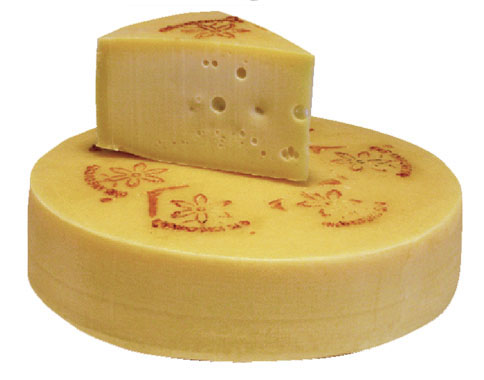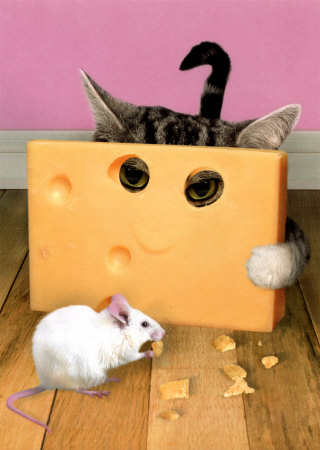Be Wary Of
Cheese
Cheese is one of the most
popular dairy products in this country as well as abroad. When the Stanford Heart Disease Prevention Program asked its participants what they found to be the most difficult change in their eating habits, the answer was surprising. It wasn’t ice cream, eggs, or desserts. No! For the majority of the people, cheese was the hardest food to trim from their diet.
America’s
Favorite—
Cheese
Cheese wasn’t always so
popular in the United States. It has only been in the past 50 years that America has adopted this love affair with cheese. Back in 1910
the Americans ate a mere five pounds per person per year. Now the average American consumes almost 26 pounds per year. The vast popularity of pizza accounts for much of that jump.
Yet, for all its popularity, cheeses have a serious flaw.
Between 65 and 75 per cent of its calories come from fat. What’s worse, the fat in cheese is highly saturated, the kind that raises cholesterol and the risk of heart disease.
How Is Cheese Made?
How is cheese made and what chemicals go into their manufacture?
In general, the cheese is made by coagulating the casein, or protein, of milk, skimmed milk or milk enriched with cream. Then the milk extracts is subjected to putrefactive bacteria which rots it. The carbohydrates are removed from pasteurized milk. The remains are mostly protein even though about 50% of the calories are fats that are not removed. The coagulation is accomplished by means of rennet or some other suitable enzyme, souring or a combination of the two.
Rennet is a natural enzyme which curdles milk. Animal rennet is the most frequently used in commercial cheeses. Rennet comes from the digestive system
of the hog and other young mammals. Sometimes rennet is obtained from the stomach of newborn animals.
A few companies do produce rennetless cheeses, which are made with vegetable coagulants. But, not all varieties of cheese can be produced with the vegetable
coagulants such as Swiss cheese. It is not possible to produce the large holes in Swiss cheese unless the animal rennet is used.
The curd or solid coagulated mass, that results is then processed by heat, pressure, molds or other special treatment, depending on what kind and flavor of cheese is wanted.

Hard cheese (such as cheddar cheese) is made by souring milk and adding rennet. This is then heated, stirred, the solid part
(curd) separated from the liquid part (whey). During the process, calcium chloride may be added, salt is added and the cheese may be coated with paraffin or vegetable oil.
In June of 1959, the FDA ruled in favor of bleaches, which are now
permitted in many hard natural
cheeses.
As a result of the ruling, some natural hard cheeses are bleached with benzoyl peroxide, or with benzoyl peroxide mixed with potassium alum, calcium sulfate,
and magnesium carbonate.
Mold-inhibiting ingredients of sorbic acid, or its salts (potassium or sodium sorabate) or any combination of two or more of these, are permitted in cheese,
and are widely used. The presence of these preservatives must be stated on the label. Sorbic acid appears to be less toxic than salt.
Synthetic vitamin A may be added to certain cheese, since the bleaching process destroys this vitamin.
Penicillin residues in milk have caused trouble in cheeses making, since the antibiotic inhibits the starter culture.
Processed Cheese Most
Objectionable
Processed cheese is, as its name implies, a product that has gone through several more processing steps. It involves mixing several
kinds of cheese with an emulsifying agent to produce the consistency for the topping of
casseroles or grilled cheese sandwiches. Following is just a sample of a few of the emulsifying agents: Monosodium phosphate,
disodium phosphate, dipotassium phosphate, trisodium phosphate, sodium citrate, sodium tartrate, or sidum potassium tartrate. And
if you believe these chemicals are added in only minute quantities so that there is only a remote possibility of their doing you any
harm—you will be shocked to learn that it is quite the contrary. Regulations state that they may be added up to 3% of the final product. Then, artificial coloring is added, and an acidifying agent may be added, such as citric acid, phosphoric acid, etc.
The dyes that are used to color cheese also come under suspicion as being cancer- causing. Alginic acid is also used in processed cheese as a stabilizer for
uniformity of color and flavor. Methyl cellulose is used as a thickening agent in processed cheeses. Sugar may be added if the flavor demands it. The smoked flavor some cheeses boast of is prepared by precipitating wood smoke. The hydrocarbons produced by this burning process have also been incriminated as possible cancer causers.

Companies making dairy products do not want to lose profits through spoilage, so the processed cheeses are especially
treated through thorough dosages of preservatives before they reach grocery shelves. For an example, the wrappers of processed cheese have long been a source of trouble. These wrappers may be coated with preservatives—mold
inhibiters and like chemicals.
FDA TEST CHEESE
FOR CHEMICALS
Recently, the FDA tested 16 samples of cheddar cheese from around the nation. There were one hundres pesticide and industrial chemical residues in the samples,
representing eleven formulations. BHC, DDT, dieldrin, heptachlor, HCB, octachlor, and penta were found in at least a quarter of the samples. One ounce of cheddar
cheese has a whopping 6 grams of saturated fat and 10 milligrams of cholesterol as well, making it a multiple health hazard. The average cheeses-eating American eats a little less than one ounce of cheddar cheese daily.
What About Other
Types Of Cheese
Even cottage cheese is not safe
today—not only because of poor
quality milk from diseased cows,
but the ingredient that are required for processing do not have to be listed on the packaging. The manufacturers are allowed to
put any one of twenty–one different items into the cottage
cheese without listing them. A
number of preservatives may be used, along with food colors, and twenty-eight different antioxidants which nobody except the processor of the specific product knows.
Cottage cheese can be a very deceiving article of food to eat.
Sodium hypochlorite may be used in washing the curds. Diacetyl may be added as a butter flavor. Objectionable amounts of salt may be added. Annatto or cochineal may be used as dyes, and hydrogen peroxide as a preservative. Calcium sulfate (related to plaster of Paris) is used as a stabilizing ingredient. Mold retarders of scorbic acid, or its salts, are also permitted. So, as you can see, cottage cheese is far from being a natural product.
Green cheeses are processed with molds—cream cheese is processed with enzymes—and cottage cheese, and other soft cheeses with bacteria. Regardless
of what process is used, each is a process of fermentation, or DECAY!
The bacteria count of cheese is very high. Fresh cheese contains (to every gram) 90,000 to 140,000 microbes. Soft cheese that is forty-five days old was found to contain 2,000,000 microbes. Cheese on the average contains twice as many bacteria in every pound, than there are people upon the face of the earth.
Cheese can often carry skippers
and mites, even though the cheese
industry uses a chemical insecticide on processed cheese to prevent attacks from the cheese mite. This insecticide is made from pyrethrins and piperonyl
butoxide. It is so strong that the
manufacture guarantees that the
cheese will not be attacked by insects during the entire time that it is aging. Just how much of the insecticide seeps through the paraffin covering into the cheese? Is it harmful? The skippers or mites are simply the larvae, or
maggot, or a species of fly, which
smells the cheese form a distance
and deposits their eggs into it. One should give it serious thought
before eating this bacteria-laden,
rotting mass.
Cheese is but (rotting) milk,
infested generally with scavenger
organisms, with a high fat content
which only deposits more cholesterol into the blood stream. Between 65 and 75 percent of its calories come from fat.
SOME
DISADVATAGES
OF CHEESE EATING!
Cheese is a product of putrefaction.
Cheese has a high bacteria count.
Cheese aids growth of bacteria.
Cheese is a potential carrier of animal disease to man. Over 90% of cows are diseased today.
Cheese is difficult to digest.
Cheese contributes to constipation.
Cheese is frequently a high source of allergies.
Cheese is hard on the brain—is one cause of migraine headaches.
Whether therefore ye eat,
of drink, or whatsoever ye do,
do all to the glory of God.
1 Corinthians 10:31
KatyChamberlin freedomofhealth.org
